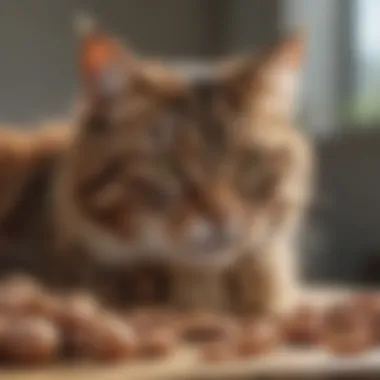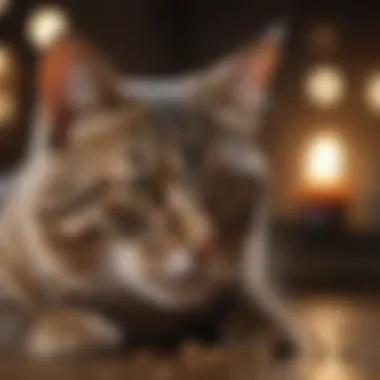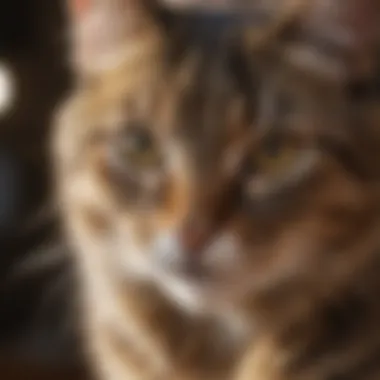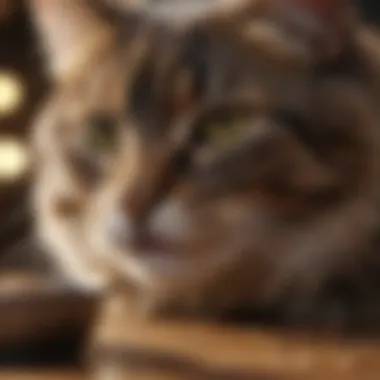Essential Nutrition for Cats: A Comprehensive Guide


Intro
Animal Profile
General Overview
Cats belong to the family Felidae and have evolved for millions of years to adapt to a hunting lifestyle. They have unique dietary needs compared to other pets like dogs. Cats require a higher amount of protein, essential fatty acids, and certain vitamins that only animal sources can adequately provide. Their ability to digest nutrients is finely tuned to their natural diet.
Habitat and Distribution
Domestic cats are found worldwide, adapting well to various environments. Initially, they were drawn to agricultural communities to control rodent populations. Today, cats thrive in diverse habitats, including urban and rural settings. Their adaptability has made them one of the most common pets globally, further emphasizing the need for understanding their nutritional requirements.
Fascinating Facts
Unique Traits and Adaptations
Cats have several physiological traits that complement their carnivorous diet. Their sharp retractable claws, excellent night vision, and acute sense of hearing provide advantages when hunting. Additionally, the structure of a cat's digestive system is specialized for processing animal proteins efficiently.
Historical and Cultural Significance
Cats have played significant roles throughout history, from ancient societies to modern households. In ancient Egypt, they were revered and regarded as sacred animals. This cultural importance underlines the need for proper care, specifically in terms of nutrition, as owners strive to keep them healthy while respecting their rich heritage.
Conservation Status
Current Population Trends
The global population of domestic cats continues to grow, with an estimated 60 to 100 million feral cats in the United States alone. While they adapt well to human presence, issues arise concerning their impact on local wildlife and the importance of responsible ownership.
Threats and Challenges
Feral and stray cats face numerous threats, including food scarcity, disease, and harsh environmental conditions. Understanding the proper nutrition for domestic cats not only enhances their health but also supports responsible pet ownership practices that benefit community ecology.
Care Tips for Pet Owners
Basic Needs and Requirements
Providing the right nutrition is fundamental to feline welfare. Cat owners should ensure a balanced diet rich in animal-based proteins. Ingredients like chicken, beef, and fish should top the ingredient list of their food.
Health and Wellness Tips
- Regular Vet Checkups: Annual visits are vital for monitoring health and getting personalized dietary recommendations.
- Hydration: Cats often require additional hydration; wet food can help increase fluid intake.
- Quality Nutrition: Investing in high-quality commercial food or balanced homemade diets ensures adequate nutrient intake.
“Understanding a cat’s nutritional needs is essential, as it directly affects their health and well-being. Knowledge empowers pet owners to make choices that enhance their pet’s quality of life.”
In summary, a deep understanding of a cat’s unique dietary requirements and the options available can significantly impact its health and happiness. Through informed choices, cat owners can promote longevity and a higher quality of life for their feline companions.
Understanding Cat Nutrition
Understanding cat nutrition is essential to ensure the long-term health and wellbeing of our feline companions. Proper nutrition supports every aspect of a cat's life, from their physical development to their immune system functionality. Not only does a nutritious diet contribute to a cat's energy levels and overall vitality, but it can also prevent numerous health issues. By understanding specific dietary needs of cats, pet owners can make informed food choices that promote optimal health in their furry friends.
The Role of Protein
Protein serves as a fundamental pillar in a cat's diet. Unlike humans, cats are obligate carnivores, which means they must consume animal-derived protein to thrive. It helps to build and repair tissues, produce enzymes, and support the immune system. An adequate protein intake is vital for maintaining healthy muscle mass and ensuring overall physiological function. Cats require a variety of amino acids, particularly taurine, which is essential for heart and eye health. Common high-quality protein sources include chicken, turkey, fish, and beef, which should be integral components of any cat diet.
Importance of Fats
Fats are often overlooked yet are equally important in a cat's diet. They provide a concentrated source of energy and facilitate the absorption of fat-soluble vitamins, namely A, D, E, and K. These vitamins play critical roles in vision, skin health, and bone health. Additionally, essential fatty acids like omega-3 and omega-6 are important for maintaining healthy skin and coat, as well as reducing inflammation. Thus, including moderate amounts of fats in a cat's diet is necessary for thorough nutrient absorption and overall health.
The Need for Carbohydrates
While cats do not require carbohydrates as a primary energy source, some level of carbs can be beneficial. Carbohydrates can provide quick energy and help to promote healthy digestion through dietary fiber. However, the emphasis should be on high-quality, easily digestible sources. Ingredients such as sweet potatoes, peas, or brown rice can serve as appropriate carbohydrate sources without overwhelming the cat's system. However, it's important to be cautious with the overall carbohydrate content, as excessive intake may lead to health issues such as obesity or diabetes.
Vitamins and Minerals


Vitamins and minerals are essential components of a cat's diet, playing various roles in metabolic processes. For instance, vitamin A is crucial for maintaining vision, while vitamin E supports cellular health. Cats also require taurine, arginine, and niacin, which can be obtained through animal tissues. Important minerals such as calcium, phosphorus, and potassium contribute to strong bones, proper nerve function, and overall metabolic health. Meeting these vitamin and mineral needs can significantly influence a cat’s longevity and quality of life.
"A well-balanced diet is not just about filling a bowl; it's a critical factor in a cat's overall health and happiness."
Commercial Cat Foods
Commercial cat foods play a significant role in the dietary habits of felines. They offer convenience, a variety of options, and often balanced nutrition tailored to a cat's life stage and health needs. Understanding these products is crucial for cat owners seeking to provide optimal nutrition to their pets.
Types of Commercial Cat Food
Dry Food
Dry food is a popular choice among pet owners due to its long shelf life and ease of storage. This type of food, known as kibble, has a high carbohydrate content. It contributes to dental health by reducing tartar buildup on the teeth. A key characteristic of dry food is its affordability compared to other types. Moreover, since dry food is less moist, it can encourage cats to drink more water, which is beneficial for their overall health.
However, the high carbohydrate content can be a disadvantage, especially if a cat is not very active. Owners need to monitor their cat’s weight to ensure they do not become overweight.
Canned Food
Canned food is often richer in protein and moisture than dry food. This high moisture content helps keep cats hydrated, particularly if they do not drink enough water. Canned food is also more palatable and can be more appealing to finicky eaters. The higher protein level is beneficial for muscle maintenance and overall feline health.
However, it is more expensive than dry food and may require refrigeration once opened. Moreover, some canned options may lack fiber, which is necessary for digestive health.
Raw Diet
A raw diet is gaining popularity among cat owners who prefer a more natural approach. This type of diet typically includes raw meat, organs, and bones, mimicking what felines would eat in the wild. The key characteristic of raw food is its high protein and nutrient content, which can enhance coat quality and energy levels. Some proponents believe it can also reduce the risk of certain health issues.
On the downside, a raw diet can pose risks if not properly balanced or prepared, as it may lead to bacterial contamination. Additionally, it can be time-consuming and more costly to produce than other commercial options.
Reading Labels for Nutritional Value
Understanding pet food labels is essential for selecting nutritious options. Labels should list ingredients in order of predominance. Look for quality protein sources like chicken, beef, or fish as the first ingredient. Avoid foods with excessive fillers, such as corn or soy, which do not provide much nutritional value.
Furthermore, it is beneficial to check for AAFCO (Association of American Feed Control Officials) statements, which indicate whether the food meets the established nutritional standards for cats.
Popular Brands and Their Reputations
There are various brands available in the market, each with its own reputation. Brands like Royal Canin, Hill's Science Diet, and Purina Pro Plan are often recommended by veterinarians for their nutritional quality. These brands have rigorous testing processes and a history of producing balanced diets for cats.
However, some pet owners also prefer smaller, boutique brands that emphasize natural ingredients and holistic approaches. It is important for owners to research brands and consider their cat's specific needs when choosing commercial cat food.
Homemade Diets for Cats
Homemade diets for cats are gaining attention for their potential benefits to feline health. This section of the article explores the relevance of such diets, how they can meet the specific nutritional needs of cats, and some of the unique advantages they offer compared to commercial options. A well-planned homemade diet can ensure that cats receive high-quality nutrients without the fillers and artificial additives often found in commercial foods.
Benefits of Homemade Food
One major benefit of homemade cat food is control over ingredients. Pet owners can select high-quality proteins, fats, and other components, ensuring that their cat gets nutritious food tailored to its needs.
- Quality Assurance: You know exactly what goes into each meal, reducing concerns about contamination or low-quality ingredients.
- Customization: Each cat is unique, and dietary preferences may vary. Homemade meals can be adjusted to meet specific health requirements or allergies.
- Freshness: Preparing food at home means it is fresh, which can enhance palatability and digestion.
- Bonding Opportunity: Preparing food for a pet can foster a deeper connection and understanding of their health.
Despite these benefits, considerations exist. It’s essential to follow nutritional guidelines and ensure the diet is balanced. Avoiding ingredients that could be harmful to cats is crucial. Consulting a veterinarian is advisable, especially during the transitioning phase.
Essential Ingredients for Homemade Cat Food
To create a balanced homemade cat diet, several essential ingredients must be included. These ingredients should provide the necessary nutrients, ensuring cats receive adequate protein, fats, vitamins, and minerals. Some key ingredients are:
- High-Quality Proteins: Chicken, turkey, fish, and beef can provide essential amino acids.
- Healthy Fats: Fish oil or chicken fat is important for energy and healthy skin.
- Cooked Vegetables: Small amounts of cooked carrots or peas can contribute fiber, although cats are primarily carnivores.
- Supplements: Minerals such as calcium and vitamins like B12 may need to be added to create a complete meal.
Always balance the diet according to veterinarian advice. A cat’s diet should never be unvaried for a long time.
Recipes for Nutritious Cat Meals
Now that the ingredients are clearer, here are a few simple recipes to inspire homemade cat meals. Each recipe can be adjusted based on your cat's preferences and dietary needs.
Recipe 1: Chicken and Rice Meal
- Ingredients:
- Instructions:
- 1 cup cooked chicken (shredded)
- 1/2 cup cooked brown rice
- 1/4 cup carrots (finely chopped, steamed)
- Mix all ingredients together in a bowl.
- Allow to cool before serving.
Recipe 2: Fish Delight


- Ingredients:
- Instructions:
- 1 can of tuna in water (drained)
- 1/4 cup pumpkin puree
- 1 tablespoon fish oil
- Combine canned tuna, pumpkin, and fish oil in a bowl.
- Serve as a treat or meal addition.
Recipe 3: Beef and Vegetable Stew
- Ingredients:
- Instructions:
- 1 cup beef (chopped)
- 1/4 cup peas
- 1/4 cup sweet potato (cooked and mashed)
- Cook beef until fully done, then add peas and sweet potato.
- Simmer for a few minutes, let cool, and serve.
Special Dietary Needs
Understanding the special dietary needs of cats is essential for their health and well-being. Different stages of a cat's life require specific nutrients. Not every cat has the same dietary requirements. Age, health conditions, and individual allergies can affect their nutritional needs. This section dives into the unique requirements of kittens, senior cats, and cats with dietary restrictions, providing insight into their special diets.
Kittens and Their Nutritional Requirements
Kittens have rapid growth and development, necessitating a diet rich in specific nutrients. They require higher protein levels than adult cats to support muscle development and energy. Fat also plays a crucial role as it provides the energy kittens need for their active lifestyle.
Key Nutrients for Kittens:
- High-quality Protein: Essential for muscle growth. Sources include chicken, turkey, or fish.
- DHA: An omega-3 fatty acid that supports brain development. Look for it in fish oil or in specially formulated kitten food.
- Calcium and Phosphorus: Critical for bone development. Many commercial kitten foods are balanced with these minerals.
Senior Cats: Dietary Considerations
As cats age, their bodies undergo many changes. Senior cats may become less active, which can lead to weight gain if their diet is not adjusted. Conversely, they might face health issues like kidney disease or diabetes that necessitate strict dietary control.
Dietary Adjustments for Senior Cats:
- Reduced Calories: Lower calorie food can help maintain a healthy weight. Brands like Purina Pro Plan have formulations suited for older cats.
- Enhanced Fiber: Helps with digestion, preventing obesity and constipation. Look for high-fiber ingredients like beet pulp.
- Proper Hydration: Senior cats may not drink enough water. Canned food can help increase their moisture intake.
Monitoring a senior cat's health is paramount. Regular veterinary check-ups allow adjustments based on their condition, ensuring they receive appropriate nutrition for their age.
Dietary Restrictions and Allergies
Cats can experience food allergies and intolerances just like humans. Identifying and managing these dietary restrictions is crucial in ensuring a cat's health. Common allergens in cat food include dairy, beef, and fish.
Signs of Food Allergies:
- Skin irritations or itching.
- Digestive issues, including vomiting or diarrhea.
- Increased scratching or grooming.
If a cat shows these signs, it may be helpful to consult with a veterinarian for a dietary change. A hypoallergenic diet can help manage common allergies. Royal Canin offers specific hypoallergenic formulas.
It is crucial to always introduce new foods gradually to avoid stomach upset.
Overall, recognizing and addressing special dietary needs ensures that all cats, regardless of age or health status, maintain a balanced, nutritious diet tailored to their conditions.
Feeding Practices
Feeding practices are a crucial component of feline health, impacting nutrition, behavior, and overall well-being. Proper feeding routines not only ensure that cats receive the necessary nutrients but also cater to their natural instincts. Understanding how to effectively manage feeding can make a significant difference in your cat's health outcomes and vitality.
Portion Control and Feeding Guidelines
Portion control is vital to maintaining your cat's ideal body weight and preventing obesity. Each cat has unique dietary needs based on its age, size, and activity level. Therefore, determining the right portion size is key. It can often be found on the packaging of commercial cat food, or a veterinarian can provide personalized recommendations. Common guidelines include:
- Kittens usually require more calories due to their growth and activity levels.
- Adults should be fed according to their weight, typically between 20 to 30 calories per pound of body weight.
- Senior cats may need fewer calories as metabolism slows down.
Using measuring cups or a kitchen scale can help maintain accurate portion sizes. Overfeeding can lead to serious health implications such as diabetes, joint problems, and heart disease. Regularly monitoring your cat’s weight and adjusting portions as needed is very beneficial.
Timing of Meals: Frequency and Schedule


The timing of meals is also an important consideration. Consistency regarding when you feed your cat helps establish a routine that can reduce stress in some cats. There are generally two main feeding schedules to consider:
- Free feeding: This approach allows food to be available at all times. Although it may work for some cats, it often leads to overeating and weight gain.
- Scheduled feeding: Serving meals at specific times during the day allows better control over food intake and can help prevent obesity.
It is also essential to be aware of your cat's natural feeding behavior. Cats are often crepuscular eaters, meaning they prefer to hunt and eat during dawn and dusk. Providing meals around these times can cater to this natural instinct.
Understanding Feline Feeding Behavior
Understanding how cats eat can profoundly influence their feeding practices. Cats naturally consume small amounts of food multiple times a day. This instinctual behavior suggests that feeding smaller, more frequent meals may be preferable for digestive health.
Additionally, environmental factors can affect a cat’s willingness to eat. Cats are sensitive to their surroundings; thus, ensuring a calm, quiet feeding environment can encourage better eating habits. Observing your cat to note any behaviors, such as preference for certain textures or flavors, may help customize their meals for enhanced enjoyment.
Regular assessment of your cat's feeding habits, behavior and weight is essential to identify any changes early.
By prioritizing these feeding practices, pet owners can significantly contribute to their cats’ health and overall joy in eating.
Evaluating Your Cat's Diet
Evaluating your cat's diet is essential for ensuring that they receive adequate nutrition. This process involves a careful examination of what your cat is eating and whether it meets their health requirements. As dietary needs can differ based on age, weight, and health status, assessment should be a regular part of responsible pet ownership. Poor nutrition can lead to a range of issues, from obesity to malnutrition, impacting your cat's quality of life.
Signs of Nutritional Deficiencies
Nutritional deficiencies can be subtle at first but, if left unaddressed, can lead to significant health issues. Some signs that may indicate a lack of proper nutrients in your cat's diet include:
- Poor coat condition: Your cat's fur may become dull, brittle, or patchy.
- Weight changes: Sudden weight loss or gain can be a clear indicator of dietary issues.
- Digestive problems: Frequent vomiting, diarrhea, or constipation can signal that your cat is not digesting food properly.
- Lethargy: If your cat seems to lack energy or becomes less active, it may be related to inadequate nutrition.
- Frequent infections: A weakened immune system can lead to increased susceptibility to illness, often due to a lack of essential vitamins and minerals.
Being observant can help you detect these signs early, leading to timely interventions.
Adjusting Diet Based on Health Conditions
Cats with specific health conditions may need customized diets to address their requirements. For instance, a cat with kidney disease might require food that is lower in protein. Similarly, overweight cats may benefit from a calorie-restricted diet to support weight loss. Always consider the following factors when adjusting your cat's food:
- Health conditions: Some diseases will require special dietary needs.
- Age: Older cats often need different nutrients compared to kittens.
- Weight goals: Weight management is important in promoting health and longevity.
It's crucial to consult with your veterinarian before making any substantial changes to your cat's diet. They can provide personalized recommendations based on your cat's health status.
Consulting With a Veterinarian
Regular consultations with a veterinarian are crucial when evaluating your cat's diet. Vets can assess overall health and suggest suitable dietary adjustments. They may conduct tests to determine specific nutrient deficiencies or dietary needs. Here are a few points to consider when consulting your veterinarian:
- Routine check-ups: Regular visits allow for ongoing dietary evaluation and adjustment.
- Dietary assessment: Vets can analyze current dietary habits and suggest improvements.
- Education: You can gain insights about proper nutrition tailored for your cat’s age and health conditions.
Ultimately, working closely with a veterinarian enables you to make informed choices about your cat's diet, ensuring a longer and healthier life.
The End
In summation, the importance of nutritious food for cats cannot be overstated. A well-balanced diet tailored to their specific needs plays a crucial role in ensuring their overall health and well-being. The core elements discussed—such as the role of proteins, fats, and carbohydrates, as well as essential vitamins and minerals—are all fundamental to a cat's diet.
Adapting feeding practices, understanding portion control, and knowing how to read labels will make a significant difference in the quality of your cat's diet. A holistic approach that encompasses these aspects can lead to enhanced vitality and longevity in your feline companions.
Nutrition directly influences your cat's energy levels and immune function. This relationship highlights the necessity for ongoing education about feline dietary requirements.
Choosing between commercial and homemade diets is a multifaceted decision. Considerations like convenience, safety, and nutritional adequacy should guide this choice. Regular evaluations of your cat's health and diet can help in making the necessary adjustments over time.
Ultimately, staying informed and proactive about your cat's nutritional needs will not only improve their quality of life but also foster a deeper bond between you and your pet.
Summarizing Key Points
- Protein is essential for growth and maintenance of muscle mass.
- Fats provide vital energy and support cell function.
- Carbohydrates can contribute to energy but are not essential in large amounts.
- Vitamins and minerals assist in metabolic processes and overall health.
- Homemade diets can be beneficial, but they require careful planning to ensure nutritional balance.
- Recognizing special dietary needs for kittens and senior cats is critical in tailoring their diet.
Future Outlook on Feline Nutrition
As research in feline nutrition advances, more tailored diets catering to specific health needs are expected to emerge. The growing awareness around pet health and wellness indicates a shift towards more holistic approaches in cat nutrition.
Potential trends include:
- Increased availability of specialty foods that cater to specific health conditions.
- Greater focus on transparency in pet food labeling, allowing consumers to make more informed choices.
- A heightened interest in sustainable and ethically sourced ingredients.
In the future, discussions surrounding cats' diets will likely integrate more scientific insights, leading to improved health outcomes. Keeping abreast of these developments will empower owners to provide the best for their feline companions.















